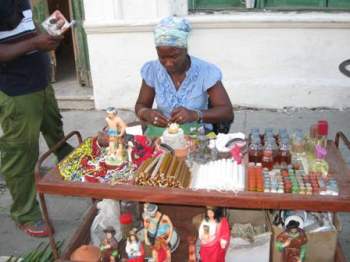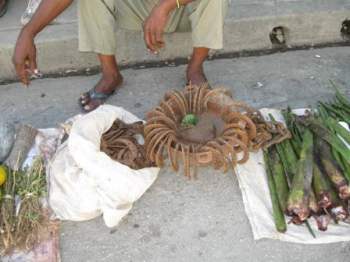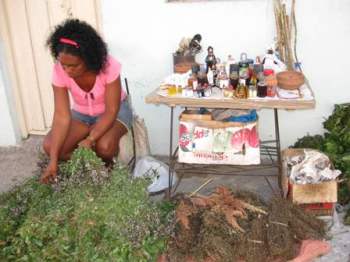‘Ache’ for Taxes
Dariela Aquique

“To go through sainting, to receive the warriors or the hand of Orula, to dispossess oneself, to remove a wuenba, to throw the conches, and Ache!” – these are some common expressions among our people.
Religions have expansive popular roots, and the belief and practice of “Afro-Cuban religions” are prevalent, with the “Regla de Ocha” and “Palo Monte” being the most common.
Among these, various names, attributes, rituals, songs and dances are quite familiar. There is not a neighborhood on December 3 (the eve of the “Chango” or Santa Barbara celebration) or on December 17 (the eve of “Babalu Aye” or San Lazaro festivities) where people don’t throw a “bembe” (a party for the saints), complete with the beating of the bata drum.

 “La Ocha” (Santeria) is currently a religious tendency that is in vogue, though it has degenerated from its ancestral essence to become a source of income. It is a means of profit for many people who in the name of religious faith charge supremely ridiculous prices for “jobs and works.” We find many “iyabbos” (initiates) dressed in white for a whole year and who comply with what is ordered of them in the “Ita” (a list of prohibitions and commands), according to the “tabero de Ifa” (sacred writings).
“La Ocha” (Santeria) is currently a religious tendency that is in vogue, though it has degenerated from its ancestral essence to become a source of income. It is a means of profit for many people who in the name of religious faith charge supremely ridiculous prices for “jobs and works.” We find many “iyabbos” (initiates) dressed in white for a whole year and who comply with what is ordered of them in the “Ita” (a list of prohibitions and commands), according to the “tabero de Ifa” (sacred writings).
What’s certain is that a consultation or to get a spiritual remedy, the amount can reach surprising figures, and these days santero priests even charge for their honoraria in hard currency. At the altars you no longer find the typical nutriment of “Patakines africanos” (Yoruba legends), but instead they offer apples and even champagne.
Practitioners compete in terms of financial solvency and it seems the saint will achieve greater power if it is made with more luxury and the hand of their “Padrino” (godfather) with more possibilities. In euros or American dollars, in convertible Cuban pesos or their equivalent in domestic currency, people are paying to increase the effectiveness of their fetishes.

 In the center of a very folkloric area in Santiago de Cuba, places like Jacobo’s house, Rosa the china’s home and the corner of Marti and Moncada streets are commonly frequented. For religious services, one can find objects and materials of all types there, including handmade idols, leaves, tools for sainting and witchcraft, etc. In this area you’ll find anything.
In the center of a very folkloric area in Santiago de Cuba, places like Jacobo’s house, Rosa the china’s home and the corner of Marti and Moncada streets are commonly frequented. For religious services, one can find objects and materials of all types there, including handmade idols, leaves, tools for sainting and witchcraft, etc. In this area you’ll find anything.
All of this is of course viewed by economists suspiciously as they have sought to bureaucratize these practices and ensure that they don’t evade the treasury and its new regulatory requirements and rates. As stated in the Gaceta Oficial, the producers-salespeople of religious articles and animals used for this purpose will have to accept the plan for patents and tax payments.
So now even the santos will be contributing their little bit to the “restructuring” of the country’s economy. “Ache!”
